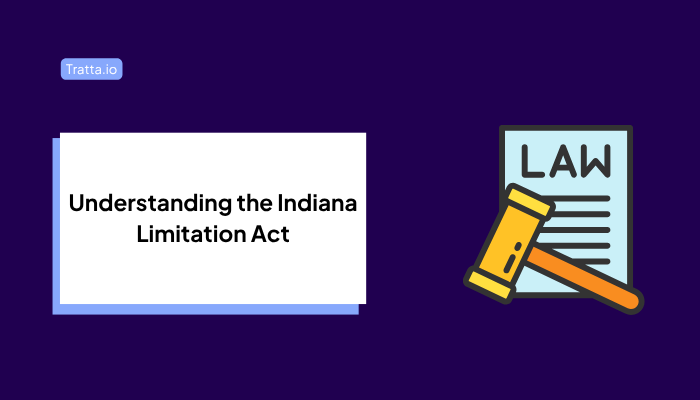
Time limits play a big role in how debt can be collected in Indiana. The Limitation Act defines the timeframe within which creditors can take legal action on unpaid accounts, and these windows vary depending on the type of debt involved. For agencies, firms, and credit issuers, knowing these timelines helps avoid wasted efforts on time-barred accounts. It also reduces the risk of legal pushback and supports a smoother recovery process.
This guide outlines the key deadlines, exceptions, and practical takeaways under Indiana’s Limitation Act so you can plan your next steps with clarity and confidence.
The Limitation Act in Indiana establishes clear deadlines for initiating legal action on unpaid debts and other civil claims. These aren’t just routine timelines. They determine whether a case can proceed in court.
Understanding how these deadlines work is crucial for effective risk management. If an account is past its limitation period, a lawsuit might get dismissed outright, even if the debt is legitimate. That’s why tracking these windows is more than a formality. It’s a key part of maintaining an effective, legally sound collections strategy.
The limitation periods differ depending on the nature of the debt. Here are the common ones:
Once the limitation period expires, the debt may still exist, but the courts won’t enforce it. This means:
Now that we’ve covered why the Limitation Act matters, let’s take a closer look at the specific deadlines it outlines.
Also Read: Nevada Statute of Limitations Explained
The Indiana Limitation Act outlines exactly how long you have to bring different types of legal actions to court. If you’re managing collections or representing creditors, understanding these timeframes is crucial for avoiding invalid claims and unnecessary legal expenses.
Here’s a breakdown of the key limitation periods to keep in mind:
Most civil cases fall under these core rules unless specified otherwise.
Tort claims, such as negligence or injury resulting from someone’s actions, follow shorter timelines.
Waiting too long can close the door on these claims, regardless of merit.
Contract cases depend on whether the agreement was written or verbal.
For debt collection, this is one of the most crucial sections, especially when recovering on credit accounts or promissory notes.
Injury claims are time-sensitive and often come with heightened scrutiny.
Understanding the core timeframes is essential, but staying updated on recent legal changes is just as vital. The next section highlights key updates and court rulings that may affect how and when you can act on a claim.
Also Read: Understanding Colorado Statute of Limitations on Debt
Staying current with legal changes is essential for any collection agency or firm working in Indiana. The Limitation Act may not change often, but when it does, those updates can have serious implications for case timelines, claim validity, and legal exposure.
Here’s what’s changed recently, and what may be on the horizon:
While Indiana’s limitation statutes have remained mostly consistent, there have been targeted updates worth noting:
Indiana courts have shaped how the Limitation Act is interpreted through recent rulings:
These rulings can affect collection timelines, especially when dealing with older or disputed accounts.
While no sweeping changes are currently underway, legal experts are watching a few key areas:
Agencies and legal teams operating in Indiana should closely monitor these developments. Adjusting policies now may save time and avoid disputes later.
Understanding Indiana's Limitation Act is essential for anyone involved in debt collection, legal disputes, or civil litigation within the state. By grasping the specific time limits associated with different types of debts and claims, creditors, collection agencies, and law firms can avoid costly mistakes, mitigate legal risks, and streamline their collections strategies.
The statute of limitations governs not only when you can pursue legal action but also how you manage your collection efforts effectively. Being aware of critical deadlines, exceptions, and recent legal updates ensures that you stay compliant and make informed decisions about which accounts to pursue.
While the Limitation Act provides clear guidelines, it is essential to stay updated on any amendments or legal precedents that may affect how and when you can act. Monitoring changes, such as digital communication clauses or court rulings on debt acknowledgment, is key to staying ahead of the curve.
By proactively managing timelines, tracking account aging, and ensuring your collection practices align with the latest legal standards, you can reduce the risk of costly legal pitfalls and improve the overall efficiency of your debt recovery processes.
Need a simpler way to stay on top of statutes and legal deadlines? Book a free demo to see how Tratta helps collection teams track expiration dates, manage risk, and maintain compliance with ease.
Q1: Does the limitation period begin when the debt is due or when payment is missed?
The clock usually starts from the date of the breach, when payment was missed or the contract was violated, not when the debt was originally issued.
Q2: Can a partial payment restart the limitation period in Indiana?
Yes. In many cases, making a partial payment or providing a written acknowledgment of the debt can reset the statute of limitations. Keep clean, timestamped records of these events.
Q3: Do limitation periods apply to judgments too?
Yes. In Indiana, a money judgment is enforceable for 20 years; however, agencies must act within this window to collect using legal channels, such as garnishments.
Q4: What happens if a lawsuit is filed after the statute expires?
The debtor can raise a statute of limitations defense, and the court will likely dismiss the case. This also opens the door to potential legal or reputational risk.
Q5: How can we keep track of different limitation periods for each state?
A legal compliance system or automation tool can help. For example, Tratta's Reporting and Analytics features can track case aging and limitation thresholds, helping teams prioritize high-risk accounts.